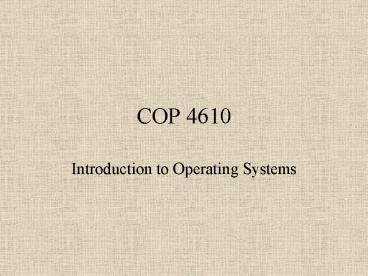COP 4610 PowerPoint PPT Presentation
Title: COP 4610
1
COP 4610
- Introduction to Operating Systems
2
Chapter 1 - Introduction
- OS - Layer between the hardware and user programs
(Figure 1.1) - OS - The ultimate API
- OS - First program that runs when the computer
boots up - OS - Program that is always running
- OS - Typically only one instance/machine
3
- An OS functions as a resource manager and an
implementer of virtual computers - As a resource manager, the OS handles hardware,
typically consisting of - Processor
- Memory
- I/O controllers
- Disk devices
- Other I/O devices
- Abstract H/W diagram Figure 1.2
4
- Resource management by an OS involves
- Transforming a physical resource into an instance
of a virtual resource (e.g., a printer) - Multiplexing between different instances of a
virtual resource when theres only one physical
resource (e.g., use of SPOOLing disk files for
virtual printers) - TDM (time division multiplexing) vs SDM (space
division multiplexing) some resources make sense
to TDM (printer) others SDM (disk) - Scheduling resources between programs
5
- An OS creates a virtual computer for each
program, with each its own - Process(es) (TDM)
- Address space(s) (SDM)
- Disk objects/file system (SDM)
- The illusion is complete Figure 1.3
- Each virtual component has its own rules
- Figure 1.4 Virtual Processor
- Some native real processor instructions are
masked new instructions are added (aka system
calls) - Pvirtual Pphysical - Priv. Instr Useful
Instr
6
- Each virtual component has its own rules
- Figure 1.4 Virtual Processor (continued)
- Separation of instruction privileges decided
(hopefully!) by hardware states system and user - Protected instructions are those which allow
indiscriminate access to the hardware (address
all of memory, access any I/O device, etc.) - Figure 1.5 Virtual Primary Memory
- Create illusion that each program has its own
private memory starting at address 0 - Figure 1.6 Virtual I/O
- Create illusion that each program has its own
set of hardware devices
7
- Figure 1.7Virtual Secondary Memory
- Create illusion each program has its own private
disk drive/file system
PowerShow.com is a leading presentation sharing website. It has millions of presentations already uploaded and available with 1,000s more being uploaded by its users every day. Whatever your area of interest, here you’ll be able to find and view presentations you’ll love and possibly download. And, best of all, it is completely free and easy to use.
You might even have a presentation you’d like to share with others. If so, just upload it to PowerShow.com. We’ll convert it to an HTML5 slideshow that includes all the media types you’ve already added: audio, video, music, pictures, animations and transition effects. Then you can share it with your target audience as well as PowerShow.com’s millions of monthly visitors. And, again, it’s all free.
About the Developers
PowerShow.com is brought to you by CrystalGraphics, the award-winning developer and market-leading publisher of rich-media enhancement products for presentations. Our product offerings include millions of PowerPoint templates, diagrams, animated 3D characters and more.

